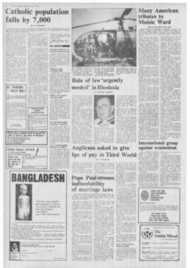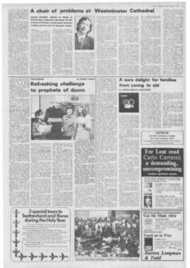Page 7, 7th February 1975
Page 7

Report an error
Noticed an error on this page?If you've noticed an error in this article please click here to report it.
Tags
Share
Related articles
Music Master Search
Westminster Cathedral Choir To Be Disbanded
Cathedral Choir Ignored Vatican Council Reforms
Leading Musicians Defend Choir
Concert
A choir of problems at Westminster Cathedral
COLIN MAWBY, Master of Music at Westminster Cathedral, discusses the difficulties of finding a compromise between tradition and the call for liturgical reform.
In these days of liturgical reform, it is far from easy to work as a church musician. The problems created by the recent changes are complex and the uncertainties affecting the future of liturgical choirmasters daunting.
The difficulties are particularly intense at Westminster Cathedral: it is after all, the centre of English Catholicism and there is a strong feeling that the Cathedral should "give a lead" in musical reform. At the same time, it has a unique tradition which is known and admired throughout the world.
It is not easy to find an effective compromise, particularly as feelings still run high about liturgical reform.
The important thing to remember is that the Cathedral is primarily a place for the worship of God. After this, it is essential to bear in mind that worship is dominated by the architecture of the building in which it is performed. Westminster is 360 ft in length, I 56ft in width, 117ft in height, and has an echo of between five and six seconds, The main organ, usually used for congregational accompaniment, is about 300ft away from the player, and this means that there is a time lag of nearly a second between the moment the organist plays the note and the moment he actually hears it. (It is not possible to use the console at the West End of the Cathedral: ' from this position the player cannot hear the con
gregution.) The building is designed so that the choir sounds at its best when singing from the Apse behind the High Altar and consequently the choir is over 50ft away from the first rows of the congregation, and considerably further from the body of the people.
It is obvious from this that there are physical limitations on the type of liturgy which can be carried out effectively. It is not possible to achieve the sense of community which characterisei worship in a parish church. The Cathedral is designed for formalised liturgy and its architecture restricts the effectiveness of congregational singing.
This leads on to the question of the difference between parish and cathedral music. The musical facilities at Westminster are greater than in a parish, after all, there is an excellent choir school and a fine body of highly competent professional singers. rile opportunities are greater and the experience which comes from tradition deeper. In these circumstances there is inevitably a big difference between parish and cathedral music.
It is clear from this that the slogan of "giving a lead" is not ,so simple as it sounds. What is the point of "giving a lead" which a parish choir cannot follow? What is the point of asking a parish choir to sing complicated music which is beyond its capabilities? And what is the point of asking the cathedral choir to produce music suitable for a parish choir? The important thing about a cathedral choir is that it sets a high standard of professional competence and provides an example which can inspire local musicians. Of course it can occasionally demonstrate simple settings, but it would be wrong to restrict it to undemanding music as this would inevitably lead to a considerable lowering of standards.
I am often criticised for the lack ofcongregationalsinging at Westminster, but here again there is a considerable difference between cathedral and parish church. In a building the size of Westminster Cathedral there cannot be the same feeling of community as exists in a small church.
The Cathedral parish has become much more diffuse as a result of the rebuilding of central London, and in the summer months the congregation, particularly at the sung Mass, contains hundreds of overseas visitors, many of whom do not speak English. Taking all this in 'conjunction with the architectural problems, it is obvious that the opportunities for congregational musical experimentation are somewhat restrioted.
My own policy has been to preserve the heritage of Catholic music — there are few establishments which have the facilities to obey this instruction of Vatican 11 — to sing any vernacular music which fits into the cathedral liturgy, and to encourage, as far as possible, congregational singing. Westminster Cathedral is unique and its problems and opportunities are also unique. The Tablet, in an article in its issue of January 11, aptly summed up the situation: "There arc those who regard cathedrals as anachronisms — as out of date. In one important sense they are, and we would support them for that reason, that they are outside time; so is the solemn performance of the liturgy, and the one does not live without the other".
There has also recently been some criticism of the repertoire of the Cathedral Choir. Certainly it has recently been reduced owing to the absence of the boys for 18 months during the rebuilding of the Choir School. In this time a lot of music was forgotten and it is a painstaking tusk re-teaching it. It is also not generally appreciated that the Cathedral Choir sings 14 services a week. (It does this with seven men, although St Paul's Cathedral employs 18 men to perform the same number of services and Westminster Abbey has 12 men to sing a smaller number of services.) The Westminster Cathedral Choir performs more plainsong than nearly any other establishment — usually the complete daily Proper of the Mass and the music for Vespers. It also sings settings by many composers — Victoria, Gounod, Poulenc, Berkeley, Mozart, Lassus, Byrd, Palestrina and others.
It is worth remembering the composers who have written specially for the choir: Vaughan-Williams for Sir Richard Terry, Benjamin Britten for George Malcolm, Sir Lennox Berkeley for me; and I have also recently commissioned a Mass from Michael Berkeley. Obviously the repertoire needs to be continually developed, but even so, the choir gets through a considerable amount of music.
Undoubtedly the liturgical life of the Cathedral and the daily choral worship of God is the most important part of the choir's work; but it must also be active in the cultural life of the country. Music is a growth in
dustry involving many people and it is right for the Church to play its own part.
European music sprang from Christianity, and most of its early development depended upon ecclesiastical patronage. roday, when hardly anyone can fail to hear at least some music each day, the Church has notably been unable to give musicians either inspiration or confidence, and this, to some extent, is one of the reasons for the unsettled state of contemporary music.
At Westminster Cathedral something can be done about this. I have always followed a policy of putting on as many musical events as possible.
Throughout the summer months there is a weekly series of recitals, many of which are broadcast, and these have attracted players from all over the world. (Those who say that modern music is never played in the Cathedral should bear in mind that the complete organ works of Messiaen have been played twice during my period as Master of the Cathedral Music.) There is a certain amount of recording in the Cathedral — Colin Davis recently recorded the Berlioz Requiem — and the Cathedral Promenade Concerts have made an extraordinary impact. Later this year a new orchestral and choral work by John Tavener is to be performed and the London. Symphony Orchestra Chorus is to give a concert in March.
As well as this, the Cathedral Choir broadcasts and records regularly. In June it is to take part in the celebrations marking the quincentenary of Windsor Chapel along with the choirs of King's College, St Paul's Cathedral, Westminster Abbey and St George's, Windsor.
The choir has sung abroad, notably at the canonisation of the Forty Martyrs, and it is to appear on a Nicaraguan Christmas stamp — a series which will includ a few of the world's most famous choirs. People come from all over the world to hear the Cathedral Choir and students from overseas often attend its practices.
I have also started at the Cathedral a semi-professional string orchestra and a large amateur choir. The former recently commissioned, with Arts Council Funds, a work from Sir Lennox Berkeley, and the latter is shortly to give its first Smith Square concert. There is a considerable amount of musical activity in the Cathedral and its high standard is generally recognised.
Westminster Cathedral is well known by people of many faiths for its mystique and mystery. It would be tragic if its music was allowed to degenerate. I hope that sufficient money will be found to prevent this from happening.
blog comments powered by Disqus











